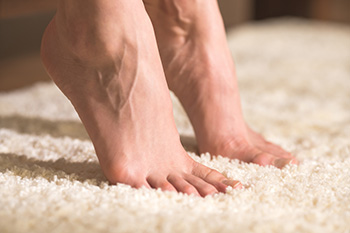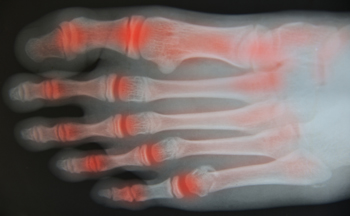Items filtered by date: August 2022
A Popping Sound May Indicate an Achilles Tendon Injury

An extremely painful foot injury can be classified as an Achilles tendon injury. This generally happens suddenly from increasing speed and frequency too quickly while running. The Achilles tendon is located in the calf, and it connects the heel bone to the calf muscles. There can be a “popping” sound that is heard as the tendon partially or fully tears, and this is known as an Achilles rupture. The common symptoms that many people endure with this type of injury can include pain and stiffness in the back of the heel and difficulty when walking. There is generally reduced mobility and strength, and recovery time for an Achilles tendon injury is approximately three months. Additional reasons why this kind of an injury can occur includes wearing shoes that do not fit correctly, or possibly from standing on hard surfaces for the majority of the day. Treatment may begin by keeping the weight off of the foot, and it may help to perform foot strengthening exercises. If you have hurt your Achilles tendon, it is suggested that you confer with a chiropodist who can properly diagnose this ailment, and offer correct treatment options.
Achilles tendonitis is a common injury of the Achilles tendon, a band of fibrous tissue that runs along the back of the lower leg. The Achilles tendon can also rupture, making it impossible to lift the foot. If you are suffering from heel or calf pain, please consult with Chiropodist Stephanie Poupore from North Bay Foot & Ankle. Our clinician can help you maintain the health of your lower limbs and your mobility.
Causes of Achilles tendon injuries include:
-
Repetitive stress or overuse
-
Sudden increase in activity levels
-
High impact injury
-
Calf muscle tightness or weakness
-
Altered foot biomechanics
-
Heel bone spurs
-
Underlying medical conditions that weaken the tendon
Symptoms of an Achilles tendon injury include:
-
Heel and calf pain that worsens following exercise
-
Chronic heel and calf pain
-
Sudden pain in the back of the ankle or calf
-
A popping or snapping sensation
-
Thickened lump in the Achilles tendon
-
Ankle and calf stiffness
-
Decreased range of motion in the affected foot
-
Swelling
-
Difficulty walking
Treatment
-
Resting the affected leg
-
Applying ice
-
Compressing the foot and ankle
-
Elevating the injured leg
-
Wearing orthotics
-
Low impact exercises
-
Stretches
-
Strengthening exercises
-
Non-steroidal anti-inflammatory medications
-
Cortisone injections
-
Surgery, if the tendon is ruptured
Achilles tendon injuries can be very painful and lead to reduced mobility if left untreated. If you have any questions, please feel free to contact our office located in . We offer the newest diagnostic and treatment technologies for all your foot care needs.
Foot Exercises for Healthy Feet

Foot and ankle pain is common. Keeping the feet strong can help prevent soreness and improve the overall health and flexibility of the feet. Regular exercise of the feet and ankles can help ensure that the muscles are providing the best support and keep one active for as long as possible. Examples of flexibility and mobility exercises are toe raises, points, and curls where one sits in a chair with feet flat on the floor and raises the heels, stopping when only the balls of the feet remain on the ground. This position should be held for five seconds before lowering heels. After this, raise the heels and point the toes so the tips of the big and second toe are touching the floor. Hold this for five seconds as well. Finally, raise the heels and curl the toes inward so that only the tips of the toes are touching the ground and hold for five seconds. Repeat each of these movements 10 times. An example of a strengthening exercise is sand walking, which is simply walking barefoot on the sand. It is a great way to strengthen feet and calves. An example of pain relief is toe extensions. This will help one prevent plantar fasciitis, which causes pain in the heel when walking and difficulty raising the toes. Sit straight in a chair with your feet flat on the floor. Place the left foot on the right thigh and pull the toes up toward the ankle so that there is a stretching feeling along the bottom of the foot and heel cord. Hold 10 seconds and repeat 10 times. If you have any questions about foot exercises or if you have pain in your feet or ankles, consult with a chiropodist who imparts knowledge about your condition and offers treatment.
Stretching the feet can improve their flexibility and overall strength, and can help prevent or reduce the impact of foot injuries. For more information about stretching your feet, please consult with Chiropodist Stephanie Poupore from North Bay Foot & Ankle. Our clinician will assess your condition and provide you with quality foot and ankle treatment.
Why Stretching the Feet Is Important
Your feet support the weight of your entire body as you go about your daily activities. As with any other part of your body, stretching and exercising the feet can help maintain their overall health, reduce foot pain, and prevent future injuries.
How to Stretch
There are a variety of foot stretches and exercises that you may try. It is recommended that you speak with a chiropodist to learn which exercises are best for you.
Some examples include:
-
Heel Raises - Hold onto a wall for balance as you slowly rise up on your tiptoes. Hold the position for several seconds, then lower your feet back to the ground. Repeat 10 times.
-
Toe Splay - Sit in a chair with your feet flat on the ground. Spread your toes as far apart as you can, holding for several seconds. Repeat 10 times.
-
Towel Scrunches - Sit in a chair and lay a towel flat on the floor in front of you, placing your foot on top of it. Using only your toes, scrunch up the towel pulling it towards you. Repeat several times with each foot.
-
Plantar Fascia Massage - Sit in a chair and place a round or cylindrical object (such as a tennis ball, water bottle, or foam roller) under the arch of your foot. Slowly push your foot forward and backward while applying pressure to the object. Maintain the object between your heel and toes. Do this for about 30 seconds. Repeat on the other foot.
If you have any questions, please feel free to contact our office located in . We offer the newest diagnostic and treatment technologies for all your foot care needs.
Wounds That Don't Heal Need to Be Checked
Golf Injuries of the Feet and Ankles

Golf is a great sport and can provide a wonderful outlet for recreation and socialization. You may not think that you can injure yourself playing golf, but you would be wrong. Golf injuries are often the result of not warming up properly, using improper swing mechanics, overdoing it, and having an incorrect grip and setup. Golf injuries may occur in the back, hips, elbows, knees, shoulder, wrist, hands, feet, and ankles. The feet are particularly important to provide the body with the balance it needs to stay steady when hitting the ball on all kinds of surfaces, while also providing the necessary power to complete the swinging process. Injuries may occur if you lose your footing, try to hit on an uneven surface, or practice poor swinging form. Ankle sprains, tendinitis, and inflammation can also plague the golfer, as can blisters from wearing improper shoes. To learn more about keeping your feet and ankles healthy while playing golf, or for treatment of any painful condition, contact your local chiropodist.
Injuries to the foot and ankle are very common among athletes. If you have experienced an injury, please consult with Chiropodist Stephanie Poupore from North Bay Foot & Ankle. Our clinician will assess your condition and provide you with quality foot and ankle treatment.
Common Injuries Among Athletes:
-
Achilles tendon injuries
-
Ankle strains or sprains
-
Plantar fasciitis
-
Fractures
-
Turf toe
-
Joint dislocations
-
Sever’s disease
-
Morton’s neuroma
Symptoms
Symptoms will depend on the cause and severity of the injury. Common symptoms for a foot or ankle injury include pain, swelling, tenderness, bruising, a reduced range of motion, and difficulty bearing weight or walking on the affected foot or ankle.
Diagnosis
Sports injuries are typically diagnosed after carefully examining the affected foot or ankle. This includes moving the injured area to test its range of motion. Medical history will need to be provided, as well as detailed information about how the injury occurred. Imaging studies, such as X-rays or MRIs, may be used to confirm or rule out certain diagnoses.
Treatment
Just like symptoms, treatment will depend on the type of injury and its severity. Initial treatment for many sports injuries is aimed at controlling inflammation and promoting the healing response. The acronym R.I.C.E is a helpful guide to implement for most acute injuries. This method involves resting, icing, compressing, and elevating the affected foot or ankle. In addition, anti-inflammatory medications may be administered and orthotic devices may be prescribed. For more severe injuries, surgery may be required. Lastly, rehabilitation or physical therapy may be needed to gain full functionality in the afflicted area.
If you have any questions, please feel free to contact our office located in . We offer the newest diagnostic and treatment technologies for all your foot care needs.
Arthritis of the Feet

Arthritis can affect the feet. It is a disease of the joints that may go beyond the joints to affect other parts of the body. When this happens, it is known as a systemic disease. Systemic forms of arthritis that can affect the feet include rheumatoid arthritis, systemic lupus erythematosus, and psoriatic arthritis. Osteoarthritis is not a form of systemic disease because it only affects the joints. Systemic conditions from these types of arthritis can cause a variety of symptoms like fatigue, fever, weakness, and skin complications. It is generally thought that arthritis can develop into a systemic disease from a combination of genetic and environmental factors. Those with varying degrees of foot pain may suffer from systemic disease and early diagnosis can help avoid complications. If you suffer from arthritis that is causing foot discomfort, whether having a systemic disease or not, it is suggested that you consult with a chiropodist who can help you in getting relief and treatment.
Systemic diseases are medical problems that affect the entire body. Many systemic diseases can bring about foot and ankle problems. If you have a systemic disease that affects your lower limbs, please consult with Chiropodist Stephanie Poupore from North Bay Foot & Ankle. Our clinician can help you maintain the health of your lower limbs and your mobility.
Which systemic diseases can affect the feet?
-
Peripheral artery disease - Causes inadequate blood flow to the lower limbs
-
Peripheral neuropathy - Nerve damage in the nerves that supply the feet and ankles
-
Diabetes - Can cause nerve damage, poor circulation, and a weakened immune system that can lead to the formation of poorly healing wounds on the feet
-
Arthritis - A disease of the joints that damages joint lining, it often affects the small joints of the feet and the ankle joints
-
Gout - A build up of uric acid in the bloodstream that forms crystals that can lodge in the joints
How can a chiropodist help?
Chiropodists help people who have systemic disease manage and maintain their foot health in a variety of ways. They can diagnose a multitude of foot and ankle problems, screen for certain systemic conditions, teach patients about proper foot care, and provide information about preventive strategies that patients could employ to avoid complications from their systemic diseases. Chiropodists can also treat foot and ankle problems through medications, foot and ankle exercises, orthotics, and lifestyle recommendations, among many other potential treatments
If you are living with a systemic illness that impacts your foot health, please feel free to contact our office located in . We offer the newest diagnostic and treatment technologies for all your foot care needs.
Stress Fractures In Runners

A stress fracture can be an unpleasant condition for anyone to suffer from. For runners, however, stress fractures can be particularly troublesome because the condition makes running considerably more difficult. Stress fractures in the feet can occur when a metatarsal bone develops a small break or bruise. Individuals with stress fractures can feel any number of symptoms. Most commonly, people with stress fractures might experience pain when at rest or when putting weight on the feet. Other patients might even experience swelling of some kind in the foot area and an altered running form. Runners ought to be especially mindful of stress fractures and how they develop because they sometimes occur due to overuse from running. For example, when an individual runs, they can put an extraordinary amount of force onto the bones in their feet. Over time, this force can become repetitive and eventually result in a stress fracture. If you are a runner and want to prevent the onset of stress fractures, make sure that you are wearing running shoes that fit properly. Seeing a chiropodist can also help you prevent or treat stress fractures.
A stress fracture often requires medical attention as it can progress and worsen over time. Please consult with Chiropodist Stephanie Poupore from North Bay Foot & Ankle. Our clinician will assess your condition and provide you with quality foot and ankle treatment.
A stress fracture refers to a fine crack in a bone. This type of fracture is especially common in the feet, as they often endure repetitive pressure from daily activities such as walking or running. Stress fractures occur when the affected bone can not support the load being placed on it. Stress fractures in the foot can occur in any bone, but often affect the metatarsal bones which connect the toes to the rest of the foot, the heel bone, or the navicular bone on the top of the foot.
Symptoms
Symptoms of a stress fracture may include:
-
Deep, dull pain
-
Sharp, localized pain
-
Intermittent pain
-
Tenderness
-
Weakness
-
Swelling
-
Bruising
-
Changes in the biomechanics of the foot
Diagnosis
Stress fractures in the foot are diagnosed via medical history and a physical exam. You may also need to have diagnostic imaging tests like X-rays, MRIs, CT scans, bone scans, or an ultrasound performed to confirm the diagnosis and to rule out any other problems.
Treatment
Nonsurgical treatment options include resting, icing, compressing and elevating the affected foot, taking nonsteroidal anti-inflammatory pain medications, modifying your footwear, wearing a cast, and using crutches. Certain types of foot fractures, such as navicular fractures, respond poorly to nonsurgical treatment and may need surgery to fully heal.
If you have any questions, please feel free to contact our office located in . We offer the newest diagnostic and treatment technologies for all your foot care needs.

